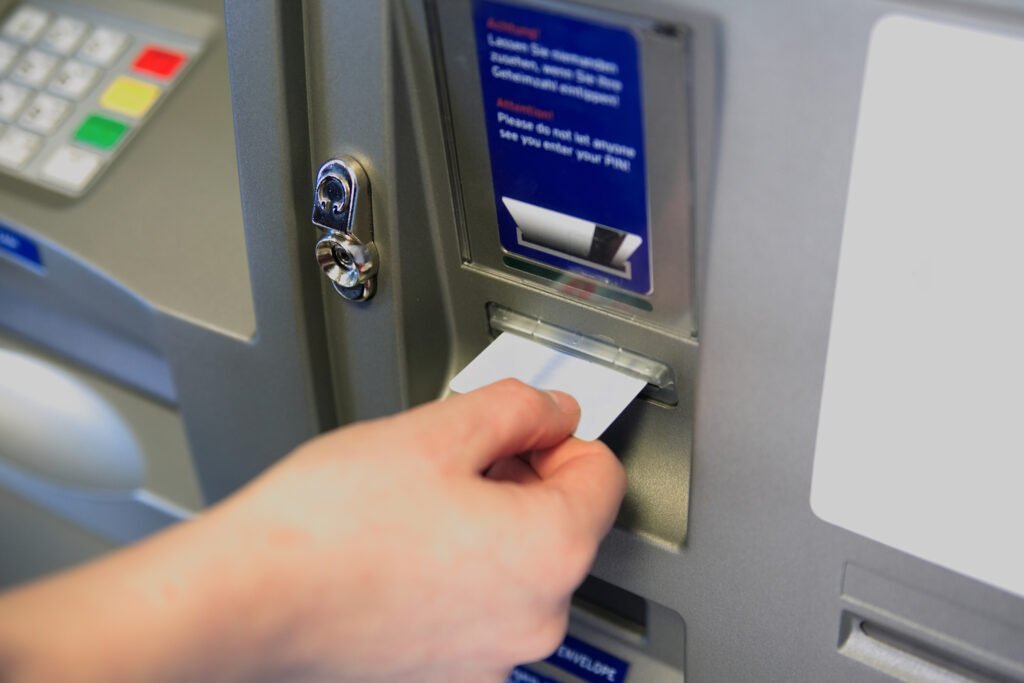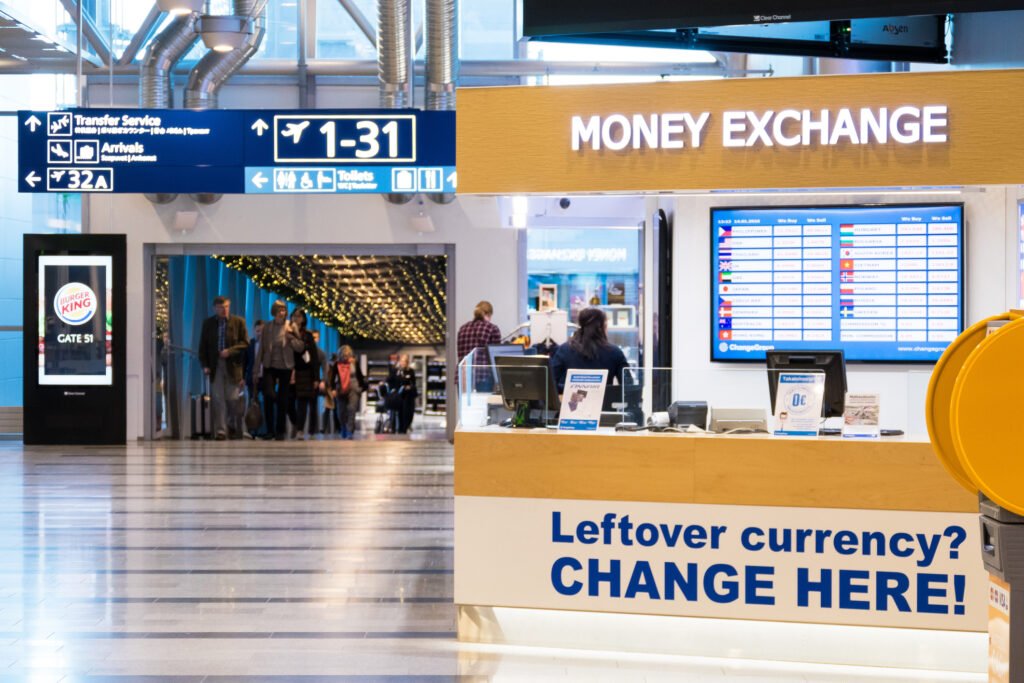How to Avoid Paying Bank Fees While Traveling
A significant part of traveling overseas involves managing your money smartly to avoid unwanted expenses and knowing how to avoid paying bank fees while traveling is one way to do so. One such headache that many travelers face is crazy bank fees, whether that be ATM fees or foreign transaction fees or something else. It’s incredibly frustrating when your hard-earned travel budget ends up reduced, not by indulgent souvenirs or a great meal, but by these pesky charges. However, there are six tips to on how to avoid paying bank fees while traveling.
Tip #1 – Eliminate or Reduce ATM Fees

When you use an ATM abroad you are going to likely accrue 3 different fees. The standard ATM fee, and international conversion fee and sometimes you bank will have an outside the network or international fee. This can really add up but there is a way to overcome this.
When it comes to ATM fees, understanding your bank’s policy is critical. Banks typically charge a non-network fee for using an ATM outside of their network, on top of which, a foreign transaction fee is often applied. These could range from $2 to $5 per transaction, or 1% to 3% of the total amount withdrawn.
Thankfully, there are a few banks that have friendlier policies for globetrotters. Here are a couple of examples:
- Charles Schwab Bank: A favorite among frequent international travelers, thanks to their no foreign transaction fee policy. With their High Yield Investor Checking Account, they will reimburse all your ATM fees worldwide. That’s right – if you’re charged any fee at any ATM anywhere in the world, Charles Schwab refunds them all directly to your account.
- Capital One 360: Their checking account charges no fees for foreign currency withdrawals. They do, however, use the Allpoint Network, so if the ATM you’re using falls outside of this network, you may face third-party charges. Capital One promises they will not charge you anything, though.
- Fidelity Cash Management: With this account, you’re reimbursed for all ATM fees. However, a 1% foreign transaction fee applies, making it slightly less perfect for international travelers compared to Charles Schwab’s offering, but still a viable option.
- Stack MasterCard: Canada-based Stack MasterCard imposes zero international ATM withdrawal fees, no foreign transaction fees, and promises excellent exchange rates. The catch is you have to load funds onto your card instead of having the ability to withdraw from a checking account.
- USAA: If you have a family member who serves in the military you may be eligible to get a USAA account. If you’re a member of USAA, their checking accounts let you use any ATM for free, anywhere in the world. USAA will refund foreign ATM fees up to $15 per month, and there is no limit on the number of free withdrawals you can make from your account in a statement cycle. This can be immensely beneficial if you’re traveling and need adequate cash for your expenses.
Before choosing your international travel banking partner, remember to read the terms and conditions of your agreement carefully. The fees can change, and there may be stipulations on how many fee rebates you can get in a given period.
Remember, eliminating ATM fees could save you a bunch during your travel. Travelling is about experiencing memories, cherishing moments, and bringing back great stories, not paying unnecessary bank charges. Choose wisely!
Tip #2 – Minimize the Exchange Rate Fees
When you head over to a foreign country, you’ll need to use their local currency. So you’ll exchange your home currency for the currency of the country you’re visiting. This involves dealing with exchange rates, which can fluctuate daily based on market conditions.
Moreover, this is where things can get a bit tricky and expensive. In these transactions, banks or other financial institutions often add a percentage on top of the current exchange rate as a fee for their service. Ideally, the best exchange rate you can get would be the “interbank rate” – the rate banks use to trade with each other. But it’s often impossible for individual travelers to get this rate. Hence, the marked up rate is often referred to as the exchange rate “penalty.”
There are several ways you can minimize this:
- Use your debit card: When you use ATMs abroad, they typically offer reasonably good exchange rates. They still include a small margin but are typically better than some other options.
- Use a credit card without foreign transaction fees: This could be quite beneficial for large purchases since credit card companies tend to offer better rates compared to those available in local exchange offices or banks.
- Pay attention to the exchange rate when you are at ATMs. Some ATMs are sneaky and will try to charge you extra or give you a bad exchange rate. So, it’s best to use ATMs in trusted places.
Remember, whatever method you choose, ensure you’re aware of the overseas transaction fees, the official exchange rate and how it compares to what you are getting and shop around for the best deal. Just a bit of research and planning can help you save significantly on exchange rate penalties, providing you more funds to enjoy your trip.
Tip #3 – Never exchange money at the airport

This really is a straightforward yet crucial tip for travelers looking to avoid paying hefty bank fees. I’m guilty of this sometimes when I’m lazy or in a pinch because an ATM isn’t working and I need cash to get into the city. So, don’t feel bad if you have to do it but I would certainly try to avoid it and plan so you don’t have to.
Ease of access and openness round the clock may portray airport currency exchange counters as the perfect place to swap your money. However, the reality is quite different. Airports are notorious for offering less-than-favorable exchange rates compared to local banks or ATMs because their operational costs are higher. Additionally, they often couple these unfavorable exchange rates with service fees.
When you land at a foreign airport, you will likely need local currency for immediate expenses like cabs, tips, or snacks. Cover these immediate expenses with a small amount of local currency brought from home or use your debit or credit card if possible. Here are some alternative strategies:
- Use ATMs: ATMs usually provide the best exchange rates compared to currency exchange services at airports. Be sure to use ATMs associated with major banks to assure legitimate exchange rates.
- Currency Exchange Services in town: If you can wait, changing your money at a local bank or currency exchange service in the city you’re visiting can also be a good option. These services usually have better rates than those at the airport.
- Pre-book Currency: Some financial service providers and banks allow you to pre-order foreign currency that can be picked up at the airport or sent to your home. The exchange rates are usually far better when compared to other last-minute options.
- Use a Travel-friendly Credit Card: Credit cards with zero foreign transaction fees can be a lifesaver in such situations. They not only provide you with convenience but also protect you from potential foreign exchange fluctuations.
- Exchange money at your bank before you go. This will get you a favorable exchange rate and you’ll have money when you land at your destination.
While airports are convenient spots for getting local currency, the convenience comes at a considerable cost. By making a conscientious decision to convert your currency elsewhere, you will reap benefits that go right back into your travel budget.So make sure to plan accordingly, and reduce or eliminate needless expenditure on bank fees and unfavorable exchange rates.
Tip #5 – Avoid Foreign Transaction Fees
When using your credit card abroad, you may be slapped with foreign transaction fees so it is important to know how to avoid paying bank fees while traveling. These are the fees that your credit card issuer charges you for processing a transaction that involves a foreign bank. Typically, the fee is about 1% to 3% of the total purchase amount. Although it may seem small at a glance, these charges can add up quickly, especially for travellers who frequently use their credit card for purchases abroad.
Here’s how you can avoid credit card fees:
- Use Credit Cards with No Foreign Transaction Fees: Today, many credit card issuers are going the traveller-friendly route by waiving foreign transaction fees. Cards like the Chase Sapphire Preferred Card, Capital One Venture Rewards Credit Card, or Discover it® Miles, offer zero foreign transaction fees, which can save you a considerable amount of money.
- Preload a Travel Card: These are specific multi-currency cards which you preload with the desired currency at a set rate, helping you manage your money and stick to your budget, without the worry of fluctuating exchange rates. Companies like Revolut, Travelex, and others offer these cards. I would only do this if you can’t get a credit card with no foreign transaction fees because the exchange rate is set and you will likely never win the bet that the exchange rate is going to get better for you because they usually pad it a bit higher so it ends up being not such as great deal normally.
- Cash Withdrawals: It is also worth noting that while it might seem straightforward to withdraw cash from an ATM with your credit card, this can come with its own fees. Cash withdrawals on a credit card are often charged interest from the day they are withdrawn, and the rate of interest is often higher than the standard rate on the card.
Tip #6 – Choose the local currency option
One of the things that can cause a dent in your travel budget is something known as Dynamic Currency Conversion (DCC). This is a service that’s offered by foreign merchants or ATMs, giving cardholders the choice to pay in their home currency instead of the local currency. While it might seem tempting because it allows you to see exactly how much you’re spending in your home currency, it’s usually exponentially more expensive.
Here’s why:
The DCC service often uses an exchange rate that is significantly higher than the one used by your credit card network. So, despite the convenience of seeing your expenses in your home currency, you’ll end up paying more due to this unfavourable exchange rate. Moreover, many card issuers will charge you a foreign transaction fee on top, even though the transaction is in your home currency.
To avoid this, always opt to pay in the local currency when making a purchase or withdrawing from an ATM abroad. By doing this, you’re allowing your home bank to conduct the conversion. Banks usually offer the closest exchange rates to the current market rates with minimal transaction fees.
Furthermore, if the machine or the merchant asks if you’d like to “lock in” or “guarantee” your home currency conversion rate, my advice would be to decline. While these options may give the illusion of certainty and convenience, they often result in higher conversion rates and subsequently higher charges.
Prior knowledge about these scenarios and how to handle them can hugely impact and potentially reduce your travel expenditure, leaving you with more to spend on experiences that truly count.
Remember, when in Rome, do as the Romans do – deal in the local currency! We hoped this how to avoid paying bank fees while traveling article helped you out! For more travel tips visit our Travel Tip section.
